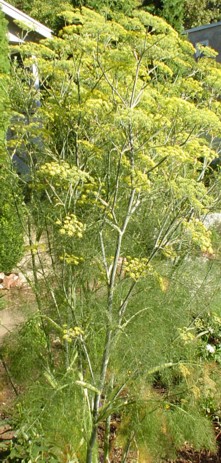Dill
|
|
| Dill | ||||||||||||||
|---|---|---|---|---|---|---|---|---|---|---|---|---|---|---|
 Dill weed, approx 6 ft. | ||||||||||||||
| Scientific classification | ||||||||||||||
|
Dill (Anethum graveolens) is a short-lived, European, annual herb. Dill seeds are used to flavor pickles; the fernlike leaves (called dill weed) are used to flavor many other foods, such as borscht. It is an umbelliferous plant, very like the caraway, its leaves, which are aromatic, being used in soups and pickles.
This name dill is derived from a Norse word which means to soothe, the plant having the carminative property of allaying pain. The common dill, Anethum graveolens, is an annual growing wild in the cornfields of Spain and Portugal and the south of Europe generally.
There is also a species of dill cultivated in Eastern countries known by the name of shubit. It was this species of garden plant of which the Pharisees were in the habit of paying tithes. The Talmud requires that the seeds, leaves, and stem of dill shall pay tithes. Jesus rebuked them for tithing dill but omitting mercy.
Classification: Dill is a member of the parsley or carrot family, Apiaceae (formerly Umbelliferae).
(Catalan anet; Spanish eneldo)
| Contents |
Cultivation
Dill can grow in areas with at least USDA Plant Hardiness Level 7. While it prefers sun, even in partial shaded areas a crop of seeds can be harvested.
History
The name dill is thought to have originated from the Anglo-Saxon 'dylle' meaning to soothe or lull. It was used by Egyptian doctors 5000 years ago and traces have been found in Roman ruins in the UK.
In the middle ages it was thought to protect against witchcraft.[1] (http://www.selfsufficientish.com/dill.htm)
Storing Dill
Dill leaves are best used fresh, so it is recommended that you keep a supply of plants, rather than store the leaves.
To harvest the dill seed cut the stalks off the flower heads when the seed is beginning to ripen. Then put the seed heads upside down in a paper bag and tie the top of the bag. Leave this in a warm place for a week. The seeds should easily separate ready for storage in an airtight container.[2] (http://www.selfsufficientish.com/dill.htm)
References
- Hamilton, Andy (2005). "Selfsufficientish - Dill" (http://www.selfsufficientish.com/dill.htm). Retrieved May. 25, 2005.bg:Копър
de:Dill (Pflanze) eo:Aneto fr:Aneth odorant gl:Aneto nl:Dille pl:Koper sv:Dill
